OCZ's RevoDrive Preview: An Affordable PCIe SSD
by Anand Lal Shimpi on June 25, 2010 2:15 AM ESTOverall System Performance using PCMark Vantage & SYSMark
Next up is PCMark Vantage, another system-wide performance suite. For those of you who aren’t familiar with PCMark Vantage, it ends up being the most real-world-like hard drive test I can come up with. It runs things like application launches, file searches, web browsing, contacts searching, video playback, photo editing and other completely mundane but real-world tasks. I’ve described the benchmark in great detail before but if you’d like to read up on what it does in particular, take a look at Futuremark’s whitepaper on the benchmark; it’s not perfect, but it’s good enough to be a member of a comprehensive storage benchmark suite. Any performance impacts here would most likely be reflected in the real world.
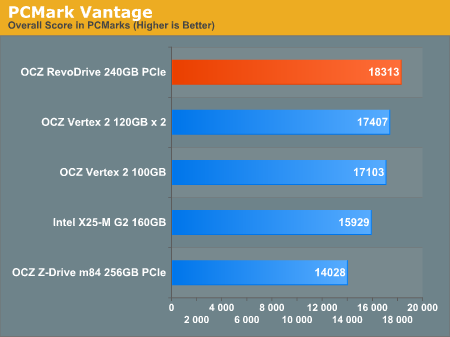
Years ago I did an article tackling the real world performance improvement by putting two hard drives in RAID-0. I argued that for most users, the performance improvement wasn’t worth the trouble. PCMark Vantage maintains that this is the case. The RevoDrive is only 7% faster than a single Vertex 2. All this tells us is that for typical desktop usage models you won’t get a huge performance boost.
The memories suite includes a test involving importing pictures into Windows Photo Gallery and editing them, a fairly benign task that easily falls into the category of being very influenced by disk performance.
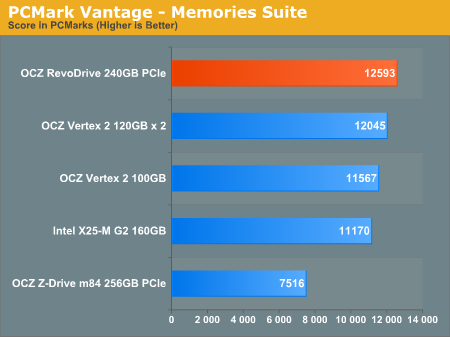
The TV and Movies tests focus on on video transcoding which is mostly CPU bound, but one of the tests involves Windows Media Center which tends to be disk bound.
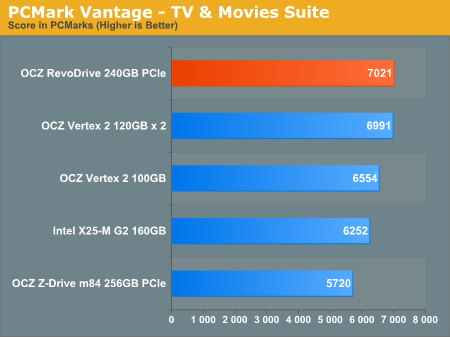
The gaming tests are very well suited to SSDs since they spend a good portion of their time focusing on reading textures and loading level data. All of the SSDs dominate here, but as you'll see later on in my gaming tests the benefits of an SSD really vary depending on the game. Take these results as a best case scenario of what can happen, not the norm.

In the Music suite the main test is a multitasking scenario: the test simulates surfing the web in IE7, transcoding an audio file and adding music to Windows Media Player (the most disk intensive portion of the test).
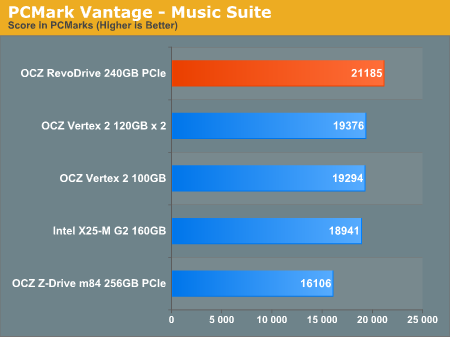
The Communications suite is made up of two tests, both involving light multitasking. The first test simulates data encryption/decryption while running message rules in Windows Mail. The second test simulates web surfing (including opening/closing tabs) in IE7, data decryption and running Windows Defender.
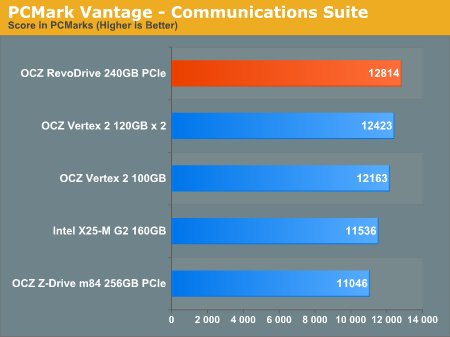
I love PCMark's Productivity test; in this test there are four tasks going on at once, searching through Windows contacts, searching through Windows Mail, browsing multiple webpages in IE7 and loading applications. This is as real world of a scenario as you get and it happens to be representative of one of the most frustrating HDD usage models - trying to do multiple things at once. There's nothing more annoying than trying to launch a simple application while you're doing other things in the background and have the load take forever.
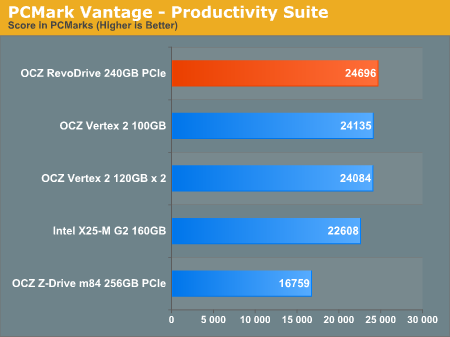
The final PCMark Vantage suite is HDD specific and this is where you'll see the biggest differences between the drives:
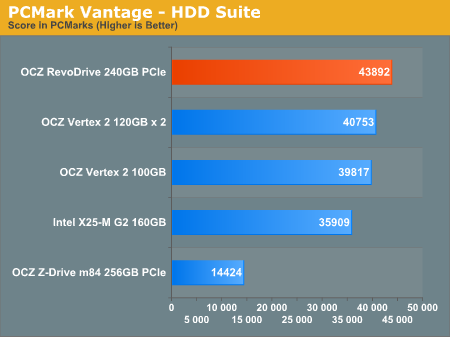
SYSMark 2007 hammers the point home as well - if you’re running more CPU bound tasks you won’t see a benefit to the RevoDrive.











62 Comments
View All Comments
nurd - Saturday, June 26, 2010 - link
The SiI 3124 is just a standard SATA controller; the RAID is software.And not everybody uses drivers written by Silicon Image, or for Windows :)
Nomgle - Monday, July 5, 2010 - link
Erm, that's completely wrong - i suggest you read this review again, and pay careful attention to the RAID-setup screenshots...The Silicon Image 3124 used on this card, IS a RAID controller, and does require drivers.
vol7ron - Friday, June 25, 2010 - link
"The PCIe x8 card was made up of four Indilinx barefoot controllers configured in RAID-0, delivering up to four times the performance of a single Indilinx SSD but on a single card."Is this something that you witnessed?
When you have 4 channels of RAID-0, I thought the performance was more exponential. 2 drives/memory chips in parallel may be twice the performance, but 3 drives would be more like 4+ times times the performance.
I think having the daughter board would really change things.
Also, doesn't Intel have a TRIM driver for their RAID controller?
vol7ron
Mr Perfect - Friday, June 25, 2010 - link
It should be linear growth, minus overhead.Performance would have to be additive. Three drives can't be four times the performance of one drive. If one drive achieves 55.7MB/s, then you could theoretically get 55.7x3=167.1MB/s from three or 55.7x4=222.8MB/s from four. Considering each drive will only ever be able to put out 55.7MB/s, then how could three achieve 222.8 total? Dividing the 222.8MB/s by 3 would give you 74.2 MB/s output from each drive, when they are physically only capable of 55.7MB/s each. The math would get even wonkier as you scaled higher up the exponential curve.
kmmatney - Friday, June 25, 2010 - link
You really need to include SSDs and hard drives in the Benchmarks feature of this website. It would really help for people upgrading from older drives, such as first gen drives, or other drives that you wouldn't be able to inlucde in teh benchamrks for every single review.knowom - Friday, June 25, 2010 - link
I'm still waiting on a modern I-Ram priced reasonably with PCI-E bandwidth with a flash card slot for data retention preferably accessible from the PCI-E retention bracket for convenient access and ability to make it hot swappable and DDR3 dimm slots angled diagonally so you could fit more dimm slots and the manufacturer could fit more easily by elongating the PCB like with video cards as well.How a modern I-Ram device would be done ideally
except angled more optimally for capacity in mind
---------------------------------------------------------------------
| | dimm slots |
| Flash | / / / / / / / / |
| | / / / / / / / / |
| ---------------- / / / / / / / / |
| / / / / / / / / |
| PCI-E / / / / / / / / |
--------__________-------------------------------------------
iwodo - Saturday, June 26, 2010 - link
Until SandForce SATA 3.0 version of Controller comes out. It will be faster then Revo.The Next Mile Stone is 1GB/s, while making it stays the same price........
sunshine - Saturday, June 26, 2010 - link
Regarding the 64GB Crucial RealSSD C300:This 64 GB version of this SSD, has a much slower write speed than the 256 GB version.
Write speeds vary with capacity:
70MB/s for the 64GB model, 140MB for 128GB and 215MB/s for the 256GB.
So apparently there is a trade off, lower price, but lower speed as well.
lukeevanssi - Saturday, June 26, 2010 - link
I am thinking of buying a E-revo 1/16 scale. I was wondering how well does this truck drive on grass if i put dual battery packs on it?. Can it climb well on dirt mounds? Thanksif anybody want to know more about it so plz visit this link:-
http://www.healthproductreviewers.com/force-factor...
there is a lot off knowledge about this product
529th - Saturday, June 26, 2010 - link
My Vertex LE died about 2 weeks ago.